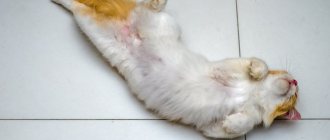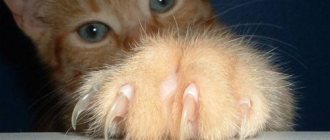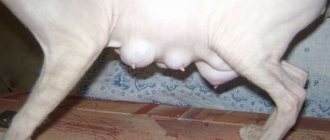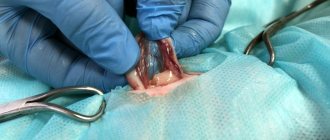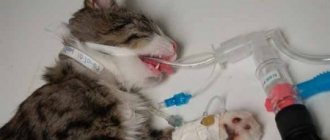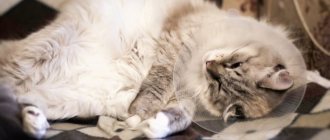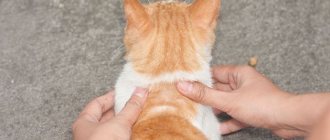We thought for a long time whether to sterilize the cat? We looked for information on the Internet and asked friends. Everyone said it was necessary.
There are many reasons for this, all good. City cats experience severe discomfort during empty heats. Therefore, they scream loudly, mark, and become aggressive, which also causes great inconvenience to their owners. We have not found a single article that would convince us otherwise, and we really want to hear the voices of those who are opposed to sterilization of cats.
Veterinarians still cannot decide at what age it is better to sterilize a cat. In one clinic we were told that after 8 months, in another from 6 months, and there are also those who are ready to sterilize at 4 months.
Our cat managed to experience her first heat before sterilization; she was not aggressive, did not shit, but meowed loudly and was annoyingly affectionate.
We made an appointment for Aliska for sterilization over the phone. The choice of the clinic fell on its proximity to home. Not very close - 1.3 km, but you can walk there. We were told that on Saturday evening we should remove all the food, leaving only water. In the morning it was necessary to remove even the water. And so they did. The poor cat meowed pitifully and did not understand why we were doing this to her. If only she knew what awaited her next!
The first day. Cat sterilization
Aliska was weighed - 2500. They said that the weight is normal for an eight-month-old cat, although she seems too thin to us.
Weighing is carried out to determine the dose of anesthesia
They quickly gave two injections, she didn’t even have time to flinch. They put him back in the carrier. They filled out all the papers and sent us out for an hour. About 50 minutes later they called and said that we could pick up the cat. They came for her, they were sure that Alice was sleeping, but she was sitting in the carrier with her eyes wide open. It turns out she was given an injection to bring her out of anesthesia.
We paid 3400 rubles for sterilization.
The price includes a blanket, syringes, etc.
They brought it home and sat quietly in the carrier. From us to the veterinary clinic is a 15-minute walk.
They immediately let him out of the house, the poor fellow is dressed in some kind of blanket, walks staggering, or moves around rolling on the floor.
The first minutes at home after sterilization
She gave me some water from my hand, I felt a little nauseous.
I slept mostly in a tent house next to soft toys.
Predisposing factors and how to combat them
Currently, not everything is known about the causes of arthritis. It has many varieties, among which it should be noted: osteoarthritis, gout and rheumatoid arthritis . Each type has its own characteristic features, but at the same time, there is also a lot in common between them: pain when moving, severe lameness, inflammatory processes. The latter (in especially advanced cases) can lead to the development of sepsis and complete destruction of the joints.
There is also “occupational” arthritis. This type of pathology is characterized by the fact that pathological changes in the joints occur as a result of many years of repeated stress on the limbs. For example, chronic arthritis can occur (due to the specifics of the “profession”) in circus cats. But this, of course, is truly exotic. Much more often, the causes of arthritis and the lameness it causes are much more commonplace.
Often the disease is provoked by a cold infection, severe bruises and bites in the joint area , and constant contact with toxic substances. Sometimes an exclusively fish or “dry” (that is, the cat is fed only dry food) diet contributes to joint disease. Rare cases of psychosomatic arthritis appearing in particularly sensitive pets against the background of serious stress (after sterilization, for example) have been described.
How does the disease manifest? The cat begins to limp heavily, every movement causes her severe pain. The joints may become noticeably swollen, and when palpated, it is easy to notice an increase in local body temperature. As a rule, animals react aggressively to attempts to probe them: they meow hoarsely, try to scratch the owner and run away.
Second day
In the morning at five o'clock I started looking for Alice. Masha (the owner) doesn’t have a cat, there’s no cat in the kitchen. Nowhere. It turns out that he is sleeping, or rather, lying, next to my sofa. She began stroking and climbed onto the sofa. I fell asleep there. I tried to give her some water - she refused, I wet her tongue, and that was all I could do. Then she gave wet food from her palm and ate a little. Now he sleeps on the sofa.
So she slept almost the whole day, gave her jelly-like Felix from the palm of her hand two more times - this is her usual food. And in the evening I already came to my bowl and ate almost half a bag and drank water.
Prevention and therapy
Proper nutrition plays an important role in the treatment and prevention of all forms of arthritis. This pathology, first of all, is the deposition of calcium in cartilage and joints. It occurs as a result of excessive consumption of canned food, cereals and baked goods . In short, this is another reason to completely reconsider the diet of your “fluffy”. The success of treating and preventing arthritis largely depends on a balanced diet. The daily diet (especially for old cats) should include boiled and pureed vegetables, but fatty meat, canned food and “handouts” should be completely excluded from the human table.
Day three
We woke up in the morning, the blanket was lying somewhere, and Aliska was sitting there licking her wounds. I'm shocked! They grabbed this weightless miracle and with difficulty put on the blanket. Most likely it’s wrong, but today we’ll get an antibiotic injection, they’ll tell us. In general, I read in people’s reviews that you can put a nylon stocking on a cat after cutting it out, she definitely won’t take it off. I also saw on the Internet special collars for the neck, with them she will not be able to reach the seam.
I pushed her into the carrier with difficulty, she desperately struggled and meowed. We went for an injection, it’s strange that the doctor scheduled it for someone other than her shift. The nurse looked at the suture and said everything was fine. I treated it and then gave it an injection. We paid another 148 rubles for this.
I asked the nurse about the tights. She was indignant - these are synthetics, they don’t breathe, the cat will snort under them, and then she will have to treat them.
I also forgot to ask what kind of surgery it was, did they just cut out the uterus? Or along with the pipes?
Now it’s only the 23rd to go to the doctor to have the stitches removed, how will we survive the week and one day?
In the morning Aliska also had an appetite, but after the injection it disappeared again. And, in general, my health worsened. She again lay with her eyes open and did not eat anything. And the cat began to walk backwards.
Receipt for an antibiotic injection
Arthritis and arthrosis
Arthrytis (arthritis) translated from Greek means “joint inflammation.” This is one of the most common pathologies that affects old cats everywhere. Arthritis that affects one joint is called monoarthritis in veterinary medicine, and disease of two or three joints is called oligoarthritis. If not one or two, but all joints of the limbs suffer, then the name of the diagnosis changes - polyarthritis . What is arthrosis? This is the name of an inflammatory-degenerative disease, which is generally characterized by the same pathological changes in the joints.
But its essence does not change. The joints do not hurt so much without movement, without load on them, but more so with load and active games. In this case, the cat becomes very weak, completely or partially refuses to eat, and the body temperature may rise. Arthritis affects not only the joints, but also the internal organs. Among the main reasons leading to the development of the disease, veterinarians identify the following factors:
- Heredity , about which we have already written a lot above.
- A “lying down” lifestyle, that is, pathology very often affects castrates who are prone to low activity and rapid weight gain. If a “well-fed” cat begins to constantly fall on its front paw, it should be taken to the doctor immediately.
- Unbalanced diet. This is typical for pets whose owners “don’t bother” with choosing the right, complete diet.
- We can also mention our ecology, which has a detrimental effect on the health of not only humans, but also their pets.
- Various infections .
Day four
In the morning we gave Aliska Felix solid food. She ate it with pleasure and also asked for more. But I haven’t really gone to the toilet yet. Although yesterday I was pushing in the tray. It’s difficult to get into the tray, so we removed the sides for now.
During the day everything lay in the hallway on the rug. But she herself came to the kitchen and meowed at the tray. Smart girl. She's already starting to purr when I stroke her head. The body is all tense, the ribs are sticking out, the poor thing is so thin.
Why are they making fun of me? It's better to leave them
In the evening, Alice went to the toilet a lot. Usually she diligently buried her feces in the filler, but here she left everything in sight. Rejoice.
He already walks around the house more. She looks longingly at the window, but I’m afraid to sit her on the windowsill in case she falls off it.
Elbow dysplasia
This disease is not considered the most typical for cats, but... Yes, in the case of outbred “Murks” everything is exactly like that. They practically do not suffer from this pathology; cases are extremely rare. It’s just that in recent years things have been much sadder with purebred cats. The problem is selection. More precisely, in poorly carried out selection: many animals end up in breeding that should not have been allowed there, as a result of which the breed acquires many “bad” genes. The characteristics of the pathology are as follows:
- As is easy to understand, the forelimbs are affected (as a rule, the pathology is well manifested only on one paw).
- The disease is hereditary . If you do not know the breeder, and there are no people among your acquaintances who bought kittens from him, it is better not to take risks. Animals must be purchased only from trusted persons who will not allow sick pets into breeding.
- Elbow dysplasia is diagnosed at the age of two or three years, or even earlier.
- The severity of symptoms varies greatly from cat to cat. Your pet may be lucky, and then he will only be bothered by intermittent claudication, or he may be unlucky, and then without surgery he will not be able to fully move.
Therapy (full) is exclusively surgical . Anti-inflammatory drugs, painkillers, etc. are prescribed only in mild cases when the body’s compensatory reserves have not yet been exhausted. When the cat is already noticeably falling on the sore paw, drug treatment will not give much effect.
Day five
Again this girl took off her blanket at night. Good girl, the cat needs to wash herself. This time it was easier to put it on Alice. When they dressed her on Wednesday, the cat’s body was somehow tense, but now it’s softer. Eh, I have to wait another week before the stitches are removed. I don’t see what’s going on with her.
Blanket inside
Today she no longer lies on the rug in the hallway, she moved into a house with toys. He sleeps there. But when I looked at her, it turns out that she had pulled the blanket off the wound and was licking her seam. Such a hooligan. I had to tie it tighter.
Aliska feels calmer with soft toys
And in the evening she fiercely licked the blanket at the seam. Apparently the wound is healing and itching.
Lameness due to infection
Sometimes infections such as mycoplasmosis or chlamydia can cause lameness. With such diseases, the joints of not just one paw, but all of them, are most often affected, so the cat limps on one or the other. Pain in the limbs occurs due to inflammation of the joints, which is caused by infections.
If the cat begins to limp on its front leg, it may have become infected with calcivirus. This disease of an infectious nature is very easily transmitted from a sick animal to a healthy one. For prevention, many cat owners vaccinate them against this disease. Animals that have not been vaccinated can become ill with calcivirus very easily.
In addition to lameness, signs of this disease may include:
- breathing problems;
- conjunctivitis;
- nasal discharge;
- damage to the paw joints;
- the presence of ulcers on the mucous membranes.
This disease causes inflammation of the anterior joint chambers. This is why the cat is limping on his front leg. What should owners do in this case? If you have calcivirosis, the animal should, of course, be shown to a specialist. Treatment in this case is complex – therapeutic and symptomatic.
Another infection that can cause lameness in a cat is a fungus. In this case, dermatophytes often affect not only the animal’s pads or its skin, but also its claws or joints. Lameness in cats in this case develops due to inflammation.
Day ten
In the morning, our cat was again without a blanket, so I quickly put it on for her. And then we see, she’s hallucinating again. He walks backwards, then they realized that it was just the blanket that was in the way, that it was put on incorrectly. We decided to take it off and not wear it again. The cat immediately became playful, runs around the house, has fun, and grabs our legs with its paws. The appetite is excellent.
The threads are sticking out
In what cases should a cat be taken to the veterinarian?
If you notice lameness in your pet, immediately identify the cause of the problem. If the wound is open, you need to disinfect it by removing the hair around the injury and rinsing the lesion with a solution of furatsilin. After this, apply a sterile bandage and take it to the veterinarian.
Avoid self-medication! At the clinic, the doctor will take an x-ray and make a diagnosis. If necessary, a fixative bandage is applied; in difficult situations, a splint or plaster cast is used. The animal is given anti-inflammatory drugs and antibiotics.
When is specialist help needed? When the animal exhibits at least one of the following symptoms:
- the cat cannot walk at all or moves with great difficulty;
- when you touch the paw, the pet meows and abruptly pulls it away;
- the cat does not step on its paw, tucking it in when moving.
It is also worth visiting a specialist if the cat’s lameness is accompanied by loss of appetite, high fever, increased fatigue, lethargy or aggression. These are already very alarming symptoms.
As already mentioned, a limping animal should be left alone for one day and then taken to a veterinarian. Also, if a bruise is revealed during examination, you can apply cold to the affected area for 1 minute, wait 20 seconds and apply again for 1 minute. This operation should be repeated for 5 minutes.
If the owners suspect that the cat has a fracture, he needs to try to fix the paw. In this case, the animal must be taken to the clinic in an immobilized state. You can also try to provide first aid to a cat if he has a minor wound. In this case, the affected area must be carefully cleaned from dirt with a cloth soaked in soapy water. After this, the wound should be treated with furatsilin solution and the animal should be taken to the veterinarian.
Day eleven, removal of stitches
Before the hospital I put a blanket on Alice, she struggled and ran away, but I managed. I also didn’t want to get into the carrier. She meowed pitifully all the way. There's another nurse there again. She ruined the whole impression of the hospital; if the doctor and nurses were friendly and inviting, then this woman amazed me. She didn’t let me take off the blanket herself; she demanded that I take Aliska by the scruff of the neck. When I didn’t understand, she picked it up by the fur herself. I categorically refused to do this. The nurse grumbled that the cat would scratch her. And I was “scratched” by the negativity coming from her.
The stitches were removed quickly, the nurse and I held, and the doctor removed. They paid 100 rubles to remove the stitches.
The threads are pulled out
That's all. The first days dragged on for a very long time, then it got faster, but we survived them. A total of 3,695 rubles were paid for sterilization. I hope that everything will be fine for Alice in the future.
It’s very interesting, who lives in a city apartment with an unsterilized cat, does she really behave like a nymphomaniac? And how do you feel about sterilization?
What to do if your cat has a sore paw and is limping
If it is not a tiny wound, not a slight bruise, but long-term lameness, the animal must be shown to a specialist. Elementary inattention, negligent attitude towards the health of a pet and attempts to treat lameness on your own often lead to complications, even disability, since it is impossible to make an accurate diagnosis without a medical education.
Important! Many dangerous diseases that cause lameness can only be treated surgically. In any case, only a doctor can identify the disease and prescribe treatment.
Prevention of arthritis, arthrosis, vitamin deficiency
Main causes of lameness
In addition to illnesses, other factors can affect a cat's gait.
- Standard routine vaccination. After the injection, the cat’s paw hurts, does not step on it at all, or occasionally leans on it. The person usually limps on the limb into which the drug was injected. As a rule, this is not a dangerous phenomenon; the disease tends to go away quickly within a few days. If it is protracted and lasts more than 2 weeks, it is worth showing the cat to a veterinarian. Usually ointment and massage are prescribed. With the help of simple procedures carried out at home, your pet will quickly recover.
- Sterilization of the animal. Although it is considered an ordinary operation, it is still a surgical intervention. The cat may limp for some time, but with proper care and the absence of infection, it will quickly recover.
- When the cat experiences stomach pain due to perforation or foreign bodies, the integrity of the tissues, including nerve endings, is disrupted. In this case, lameness is only one of the symptoms of a serious condition. Usually the cat is bothered by vomiting, bleeding from the anus, and general weakness. If all of the above signs are present, the pet must be urgently taken to the clinic. The diagnosis can only be made by a specialist after a detailed examination and review of test results. Surgery is often required.
Accidental cuts also cause lameness
- Cut wounds, bites. The cause of lameness may be hidden in an ordinary wound that the owners did not notice during examination. The cat could have cut itself by jumping on the glass, or been bitten by a dog. It is necessary to examine the sore paw again, finding damage, treat it with any antiseptic, and apply a bandage. The wounds heal quickly, and lameness goes away if they are not associated with infection.
- With infectious inflammation of the limbs, in addition to lameness, the cat’s temperature rises, general tone decreases, and appetite disappears. When palpating the inflamed area, purulent discharge can be detected. In this case, the cat reacts sharply to pain, meows, escapes from the hands and hides from the owners. The wound must be treated and bandaged. To prevent complications, you should show it to a veterinarian.
Cats are distinguished by their activity, which sometimes causes them to suffer. Their excessive mobility can cause injuries of various origins. If you notice that your cat is limping on its front leg, then you need to contact a veterinarian and undergo an examination.
Cat lameness can be caused by many things and can cause the animal significant discomfort and pain. The disease can be permanent or occur periodically, for example, only in the morning or evening. Causes of lameness in cats associated with injury are as follows:
- dislocation of the paw during games;
- splinter in the fingertips;
- sprain;
- fracture;
- claw damage.
An animal may also limp due to a specific disease:
- osteochondrosis. Occurs mainly in old cats. In this case, pinching of the spinal cord roots occurs. Affecting the cervical region, pinching leads to lameness of one front paw or both. The older the pet, the more severe osteochondrosis will manifest itself;
- elbow dysplasia. Mainly affects purebred cats. The disease manifests itself in youth and only intensifies over the years. In this case, the lameness affects either one of the front legs or both at once;
- arthritis or arthrosis. Occurs in older cats and leads to inflammation of the joints. With this disease, the cat limps on its front or hind legs. The animal begins to limp gradually. Osteoarthritis can affect older animals and overweight cats;
- osteomyelitis. Characterized by partial destruction of bone tissue. The disease can affect any of the four limbs. It mainly affects cats under two years of age. Osteomyelitis is typical for Persians and related breeds;
- infections, such as calcivirus. In addition to limping, the animal may experience nasal discharge, oral ulcers, and fever.
Your pet may not be able to step on his front paw due to damaged nails. This happens as a result of a fall from a great height or an impact. The claw can break if someone steps on the paw. This causes the animal great discomfort and pain.
There is another reason for lameness related to the disposition of the animal. For example, if you accidentally stepped on its paw and crushed it under a door, the animal will begin to limp demonstratively, expressing its resentment. The main thing is not to pay attention to this, and after a couple of hours your pet will get tired of playing and stop pretending.
If you notice that the cat is really suffering, immediately take him to the veterinarian to eliminate the possibility of complications.
An animal can limp with varying degrees of severity. Some slightly twist their paw when walking, others cannot step on it at all. Observe your pet, conduct a visual examination and run to the doctor if you notice at least one of the following signs:
- the cat cannot walk at all or moves with difficulty;
- after touching the paw, the cat pulls it away and begins to whine;
- refuses to go outside, especially if you have to go up or down stairs;
- the animal does not stand on its paw;
- with a fungal infection, a trace of dermatophytes is visible on the paws.
In addition to physical signs, your cat may lose appetite, become tired, lethargic, or irritable. If you forcefully examine a painful limb, the cat may hiss and even claw you.
What to do if you find a cat with lameness on the front or back leg? First, do not delay visiting a veterinary clinic or office. If the cause is an infectious disease, then delay in treatment can cost not only the animal’s health, but also its life. During the visit, the veterinarian will perform the following diagnostic measures:
- will look at the patient's medical history (if any). He will conduct a survey of the owner, find out whether the animal has had any injuries recently, and find out about the presence of accompanying symptoms, in addition to lameness;
- visual inspection of a limping cat. It is necessary to understand how serious the lameness is, the location of the most painful area of the limb, and the presence of abnormal places in the structure of the joints. The doctor will look at how the animal moves, runs, stands;
- neurological examination. It is carried out to exclude damage to the central nervous system, muscles, brain or spinal cord, because lameness is not always caused by orthopedic problems;
- radiograph. It will help you see the presence of cracks, tumors, growths and other problems inside the limb.
You may also need to take tests of synovial fluid, general blood and biopsy, and urine. With the introduction of the dye, studies of the spinal canal are performed - myelography. Contrast radiography or arthrography (injection of dye into the joint) is done using the same method. Ultrasound, MRI and CT may be prescribed.
When you have decided on the causes of lameness in the front paw, it’s time to start treatment. It can be simple and done at home with the help of medications, for example for a minor sprain or dislocation. More serious illnesses are treated in a hospital, and surgical intervention is possible.
In the case where lameness is associated with a splinter or other foreign body getting into the paw, treatment consists of treating the wound with a simple antiseptic. But first the splinter is pulled out so that swelling and inflammation do not occur.
As a rule, no complications arise, the wound heals within 2-3 days. Along with painful sensations, lameness will disappear. Fractures are not uncommon in active cats. If the animal breaks its paw, you should try to immobilize it before arriving at the clinic.
At the hospital, the cat will be examined and a bandage or cast will be applied.
Treatment of degenerative changes in the limbs and arthritis in cats is carried out with the help of drugs that restore the elasticity of cartilage, for example, Ketofen.
If pathological changes in the joints are caused by excess weight and impaired metabolism, the animal is prescribed a diet to reduce body weight.
READ How to catch a pheasant without a weapon: basic methods. How to catch a live pheasant - trap options and recommendations
There are cases. When it is impossible to determine the exact cause of lameness. In this case, the animal is prescribed to minimize physical activity and is prescribed anti-inflammatory drugs. Painful sensations are relieved by No-shpa, Papaverine, etc.
If lameness is caused by an infectious disease, then the root cause is eliminated first.
This is necessary to protect the animal’s body, which is already weakened by the disease. The doctor may prescribe a weekly course of Flemoxin at a dosage of 12.5 -22 mg per kilogram of weight.
The duration and intensity of treatment depend on the type of disease and its advanced stage. For example, osteomyelitis disappears with age, but osteochondrosis, arthritis and arthrosis can become chronic. In this case, constant dulling of painful outbreaks with anti-inflammatory and painkillers will be required.
When lameness becomes severe, surgery is required. Depending on the situation, the doctor may decide to replace the affected joint with a prosthesis.
If the kneecap is dislocated, if timely treatment is not carried out and the disease progresses to stages 3 and 4, surgery is prescribed. The same applies to osteochondrosis. At the beginning of the development of the disease, medications are prescribed. If the lameness does not go away, but only progresses, surgery will be prescribed to eliminate the pinched nerve.
Some cats, due to their natural predisposition, may suffer from lameness. Proper maintenance of the cat can avoid its occurrence or at least reduce the intensity of its manifestations: protect it from injury, adjust the diet, adding more foods with calcium and vitamins.
If you want to know whether a kitten will limp in the future, study its pedigree. Perhaps this is due to heredity and does not pose a danger to the health and life of the animal.
How to distinguish a fracture from a bruise on the hind leg
A cat's paw bruise is not uncommon, especially in young cats. During play, kittens actively run and jump, which can result in injury. The bruise does not threaten the life of the animal, but requires treatment to avoid inflammation.
You cannot do without medical help here.
The first sign of damage is that the animal holds the affected paw up and does not step on it. If it occurs occasionally, he tries to transfer the body weight to a healthy limb as soon as possible. A bruise can be identified by the following symptoms:
- hematoma in the injured area;
- swollen paw;
- impaired gait with lameness;
- absence of skin wounds;
- absence of displaced joints;
- local temperature increase;
- constant licking of the sore spot (the animal massages the paw with its tongue, accelerating the resorption of the hematoma);
- aggressive behavior when the owner tries to touch the damaged limb.
Fractures have their own distinctive features:
- swollen paw along the entire length, and not just at the site of injury;
- when palpating (feeling) the paw, a displacement of the joints or bones is felt;
- the animal does not attempt to step on the limb;
- due to severe pain, the pet constantly meows;
- the structure of the paw is damaged.
If an animal is bruised, you must first calm it down by picking it up and gently stroking it for several minutes. Then apply cold to the bruised area - a cloth in which ice is wrapped or a towel soaked in cold water. You need to apply it for 1 minute, then take a break for half a minute, and then repeat the procedure again. This must be done for 15 minutes.
A couple of hours after injury, you can do an alcohol rub. You should not put too much pressure on the sore spot - this will cause anxiety and stress in the cat. An alcohol compress can be applied to a calm animal, which effectively relieves swelling and pain.
Be sure to read:
The cat has a fever: what to do, reasons, what is the norm, how to bring it down at home, the best methods
In case of a fracture, it is necessary to provide maximum rest to the animal, place it in a carrier or take it to a bed. The diseased limb must be fixed to avoid displacement of bones and joints, and then urgently taken to a veterinary clinic.
If your pet is suspected of having a spinal fracture, you should move it as carefully as possible onto a rug or blanket, take it to the car and take it to the veterinarian as soon as possible. Any displacement of the vertebrae can result in damage to the spinal cord. If the jaw is broken, it is necessary to put a muzzle on the cat - this will protect it from shifting bone fragments that threaten to rupture the soft tissues.
Patella, or dislocation of the stifle, is uncommon in cats. The main reasons for its appearance are severe injuries or genetic abnormalities. The disease occurs suddenly: the animal experiences severe pain, cannot move normally, limps, and reacts to stroking with hissing and aggressive behavior. The pet constantly meows, he is scared. In such a situation, they act immediately - the animal is urgently hospitalized.
The cat limps on its hind leg without visible damage due to fractures, cracks in the bones, sprains, dislocations, or severe bruises. At the same time, it is completely impossible to distinguish a fracture from a crack at home.
A pet can limp for a variety of reasons.
With fractures and cracks in the bone, the pet does not lean on the sore paw at all, but constantly holds it suspended. Tries to move less. When trying to examine, he does not allow you to touch the sore limb. Swelling and increased temperature may be observed at the site of injury.
As first aid, the limb must be immobilized by applying a cardboard splint and securing it with a bandage. Trying not to disturb the sore paw, you need to take the cat to the veterinary clinic. After an x-ray and a detailed examination, specialists will apply a plaster cast or splint, depending on the severity of the injury.
An x-ray will show the presence of a fracture
Unlike a fracture, with bruises, the cat sometimes leans on the damaged paw, even if there is some swelling. When palpated, the injured limb causes pain. After 1-2 days, the ward will begin to rely on her more and more often. Soon the lameness will completely go away.
Patella luxation
Let us immediately note that in cats this pathology, leading to severe lameness, is quite rare , but still cases are not isolated. The following characteristics of the disease can be given:
- It affects, as you might guess, exclusively the hind limbs .
- Lameness appears suddenly and spontaneously : the cat begins to fall sharply on its hind paw, meowing in fear and hissing in surprise and pain.
- Patella luxation is usually considered a genetically determined disease, but cases have been described in which serious injuries to the extremities contributed to its development.
- Unlike dogs, in which small breeds are susceptible to this pathology, among cats, patella is most often diagnosed in “giants”, as well as castrated cats of ordinary breeds, overfed beyond measure.
Treatment depends on the stage of the disease (there are four in total). In the first two, you can successfully manage with anti-inflammatory corticosteroids, while in the third and fourth, the animal’s only chance for a full life is professionally performed surgical intervention .
pros
This placement has a number of advantages and disadvantages.
- if the owner is in a hurry to work or on business, he does not need to waste time transporting the animal to home and taking a set of primary measures;
- there is no need to take a pet anywhere that has not yet recovered from anesthesia;
- the clinic knows exactly what to feed the cat after sterilization;
- you don’t have to give injections and tablets yourself or take your pet to the veterinarian every day for procedures;
- often animals are aggressive; the owner will not have to experience this on himself;
- responsibility for the operation and recovery period falls entirely on the shoulders of doctors; specialists are well aware of the behavior of cats after sterilization;
- in some cases, if a cat has health problems, it needs specialized medical care;
- the hospital is especially convenient for sterilizing stray cats.
Symptoms
- Inability to walk or move normally
- Pet whines due to pain
- Refusal to walk and climb stairs
- The pet does not lean on its paw
When your cat is limping and you, not knowing what to do, are looking for advice on this topic on the Internet on forums, we recommend not to self-medicate or experiment on your beloved cat. The fact is that there are many causes of lameness in an animal, and the consequences of your experiment may disappoint you and your family.
Joint diseases
Also, without visible damage, the cat limps on its hind leg with serious joint diseases. Some of them are congenital and therefore develop slowly. Pathology cannot be detected by a simple examination without medical education. If you pay attention to the accompanying symptoms and promptly contact specialists, the animal can be cured without resorting to surgery.
- Hip dysplasia is a genetic disease. It is dangerous because it can progress even in young cats. Lameness is especially noticeable after prolonged rest (sleep, rest).
- Arthritis and arthrosis are common in older animals. The disease affects bone tissue, causing pathological changes. Due to pain, cats try to move as little as possible, preferring to lie down. They often refuse food and become weak. When palpating swollen joints, they react sharply to pain. The disease may be accompanied by fever.
- Patella patellar luxation, or patellar luxation, is an uncommon problem in cats. It is usually the result of severe trauma, or less commonly a genetic abnormality. It occurs suddenly, causing severe pain in the animal. At the slightest movement of its paw, the cat meows loudly. The injury requires immediate treatment, and in advanced cases, surgery.
Lack of calcium affects the motor functions of kittens
- Osteomyelitis is a disease that occurs in young cats during the phase of active growth and development. Degeneration and partial destruction of bone tissue can affect not only one limb, but all at once. The disease is characterized by acute pain in the pet, which is why even light touches cause aggressive behavior.
- Osteochondrosis, in which pinching and compression of the nerve roots in the spine occurs, causes the animal to limp in any of the four limbs. Wear of the cartilage layer of the intervertebral discs affects the cat’s ability to move easily.
- Osteosarcoma is a malignant neoplasm. Usually it is a pathology of older cats that have crossed the 6-7 year mark.
All of these diseases can only be diagnosed by a doctor at a specialized clinic. They require mandatory treatment with corticosteroids, immunostimulating and painkillers under the supervision of a veterinarian. In severe cases - surgical intervention.
Important! If there is any suspicion of joint disease in cats, you must immediately take your pet to the clinic. Delay or attempts at treatment at home can negatively affect his health and lead to death.
Temperature increase
During the first 5 days after surgery, phenomena such as lethargy, weakness, or, conversely, excessive activity are possible. Fluctuations in body temperature may also be observed, increasing to 39.5 degrees. This is not due to infection, but to tissue damage and healing. This is a normal reaction of the body. Painkillers will significantly improve your pet’s well-being. However, if the temperature is too high or persists for a week or more, you should consult a doctor.
Caring for a cat at home. Feeding
The animal's appetite returns within two days after the operation. What to feed a cat after sterilization? Just like before. Within a few days, the pet will begin to eat in the same amounts as before the operation. If this does not happen on the 5th day, then this is a sign of ill health. It is recommended to consult a veterinarian.
You need to feed little by little as soon as the pet has a desire to eat. However, if vomiting occurs, then you need to wait a few more hours to eat. To avoid problems with the collar, the diameter of the bowl should be smaller. The cup must be placed at a height of 3-6 cm.
Osteochondrosis
Yes, this disease is not limited to humans. Old cats can also suffer from it to a no lesser extent, as they begin to limp severely and lose their former mobility. By the way, how can osteochondrosis, a disease of the spine, cause lameness?
In fact, there is nothing strange about this. The fact is that with this disease the spinal roots can be pinched and pinched . The innervation of the limbs is disrupted, which is why lameness occurs. Pathology manifests itself as follows:
- Any limb can be affected; with severe pinching, even the size of the front paws (or hind paws, depending on your luck) is observed.
- It is believed that the disease develops due to a disruption in the process of normal formation of cartilage tissue in the animal’s body. Because of this, the layers of cartilage between the vertebrae (not the discs) are simply erased, the vertebral processes begin to rub “dry,” and the animal experiences severe pain.
- It is assumed that osteochondrosis in cats is a hereditary disease . Again, be more attentive to the pedigree of your intended pet before purchasing a kitten.
In the initial stages, when the manifestations of the disease are still minor, anti-inflammatory corticosteroids can be used. If progressive lameness and other signs of pinched nerves are visible to the naked eye, surgical intervention is necessary. The operation is expensive and quite risky, but, alas, it will not be possible to do without it. What other causes of lameness in cats exist?
Preparing for surgery
There is nothing tricky here. The animal must not eat for 12 hours and not drink 4 hours before surgery. This is due to the fact that the operation is performed under local anesthesia. That's all the preparation. Animals older than 8 months can be sterilized. In this case there will be no complications. It is optimal to carry out the operation before the first mating or the first desire. A month before the procedure, it is advisable to get vaccinations to protect your pet from possible complications and infections. When cats are sterilized, postoperative care is required for 1-2 weeks.
General restorative home treatments for paralysis of paws
If a cat's hind legs have failed, he will benefit from daily restorative procedures. The owner can easily work with the pet on his own at home.
- Paw massage should be done 5 to 7 times a day. For 10-15 minutes, massage your limbs with light but intense movements. This will help restore the conduction of nerve impulses and prevent the muscles from atrophying.
- Therapeutic gymnastics in the form of forced flexion and extension of the limbs is very useful.
- You can imitate walking using a kind of walker, which can be made from a wide towel placed under the cat’s belly. By supporting the animal in this way, you need to provoke it to move its paws on its own. If it is difficult for him, you can help with your hands.
- Swimming gives very good results if the cat is not afraid of water. Once in a pond or bathtub, the animal involuntarily moves its paws, trying to swim, while the owner holds it under its belly. It has been noticed that healing occurs much faster after a course of such exercises.
- Tickling the paws will help the owner feel the moment when the animal begins to feel them, by reaction to irritation.
- Exercises on the ball are effective. The cat is placed on a ball of suitable size. Her paws, hanging down, should almost touch the floor, so that when she rolls, she seems to stand on them.
If the cat’s treatment does not bring the expected effect, and it still drags its hind legs, then you should not euthanize the animal. There is a way out in this case too. There are specialized wheelchairs for cats that perform the functions of limbs. Once accustomed, the cat will be able to move quite quickly in such a stroller without the help of the owner. The quality of life of an animal when using such a device remains quite high.
If something is wrong with a pet’s health, it always causes serious concern for the owner. It is important to know the reasons why a cat’s hind legs fail and to imagine what measures need to be taken to restore the animal’s normal condition. In such a situation, you simply cannot do without a visit to the veterinarian.
Delay can often cost a cat’s life, which is why even a slight disturbance in gait, and even more so paralysis of the hind limbs, requires urgent treatment. The longer treatment is delayed, the higher the risk that the mobility of the paws will not be restored, or even that the pet will die.
Anesthesia
The most difficult period is immediately after surgery and for two days. On these days, it is advisable to give painkillers. These can be either injections or tablets (when swallowing function is restored). However, special cat medications should be given, not human ones! Painkillers will not only make your pet’s life easier, but will also allow her to feel much better, her appetite will return sooner, and her temperature will not rise much. The postoperative syndrome itself will be much less pronounced.
If the behavior of cats after sterilization does not differ from usual, then this item can be excluded from treatment measures. However, in most cases it is required.
Additional drugs
If the operation was successful and the animal itself is healthy, then it does not require additional drug treatment. However, the following groups of medications may be needed:
- Antibiotics. As a rule, one injection is given during surgery. This is necessary to avoid infection. They may be needed if the animal licks the seam. But in this case, the recovery process will drag on for another 2-3 weeks.
- Vitamins are given to weakened cats if they feel unwell during the postoperative period.
- Hemostatic agents will be needed if blood clotting is poor, if blood is constantly oozing from the suture.
- Anti-infective serum is useful if the owner decides to leave the pet for a recovery period during

